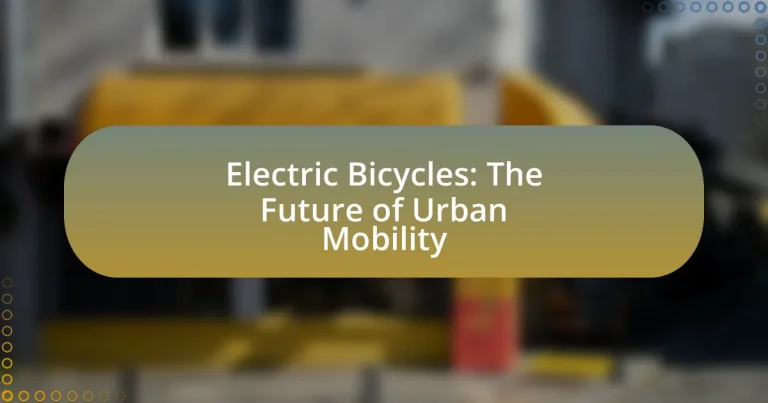Electric bicycles, or e-bikes, are bicycles equipped with electric motors that assist with pedaling, enabling riders to travel longer distances and tackle challenging terrains with less effort. This article explores the differences between electric and traditional bicycles, the key components of e-bikes, and their various types, including e-Mountain bikes and e-City bikes. It also examines the advantages of electric bicycles, such as enhanced mobility, environmental sustainability, and health benefits, while addressing challenges like infrastructure inadequacies and safety concerns. Additionally, the article discusses the role of electric bicycles in urban mobility, their impact on traffic congestion, and the importance of regulatory frameworks and technological advancements in shaping their future.

What are Electric Bicycles?
Electric bicycles, commonly known as e-bikes, are bicycles equipped with an electric motor that assists with pedaling. This motor can provide varying levels of assistance, allowing riders to travel longer distances and tackle challenging terrains with less physical effort. According to the Electric Bike Company, e-bikes can travel up to 28 miles per hour and typically have a range of 20 to 100 miles on a single charge, depending on the battery capacity and level of assistance used. This integration of electric propulsion into traditional cycling enhances the overall riding experience and promotes sustainable urban mobility.
How do Electric Bicycles differ from traditional bicycles?
Electric bicycles differ from traditional bicycles primarily by incorporating an electric motor that assists with pedaling. This motor enables riders to travel longer distances with less physical effort, making cycling more accessible to a wider range of people. Additionally, electric bicycles often feature a rechargeable battery that powers the motor, whereas traditional bicycles rely solely on human power. According to a study by the European Cyclists’ Federation, electric bicycles can increase cycling participation by up to 50%, demonstrating their impact on urban mobility.
What components make up an Electric Bicycle?
An electric bicycle consists of several key components: a frame, electric motor, battery, controller, wheels, and brakes. The frame provides the structural support for the bicycle, while the electric motor powers the bike, typically located in the hub of the wheel or at the crank. The battery stores energy to supply the motor, and its capacity is measured in watt-hours, affecting the bike’s range. The controller manages the power flow from the battery to the motor, allowing the rider to adjust speed and assist levels. Wheels and brakes are standard bicycle components, ensuring mobility and safety. These components work together to create an efficient and user-friendly mode of transportation, contributing to the growing popularity of electric bicycles in urban environments.
How does the electric motor enhance performance?
The electric motor enhances performance by providing instant torque and efficient power delivery, which significantly improves acceleration and climbing ability in electric bicycles. This capability allows riders to navigate urban environments more easily, especially in hilly areas or during stop-and-go traffic. Studies show that electric motors can increase the overall efficiency of energy use, with some models achieving up to 90% efficiency compared to traditional combustion engines, which typically operate at around 20-30% efficiency. This efficiency translates into longer ranges and reduced energy consumption, making electric bicycles a more sustainable option for urban mobility.
What are the different types of Electric Bicycles?
The different types of electric bicycles include pedal-assist (pedelecs), throttle-controlled e-bikes, and speed pedelecs. Pedal-assist bicycles provide assistance only when the rider pedals, making them ideal for commuting and fitness. Throttle-controlled e-bikes allow the rider to engage the motor without pedaling, offering a more relaxed riding experience. Speed pedelecs can reach higher speeds, typically up to 28 mph, and are often classified differently in terms of regulations. These classifications are supported by various studies indicating their distinct functionalities and user preferences in urban mobility contexts.
What are the characteristics of e-Mountain Bikes?
e-Mountain bikes are characterized by their combination of traditional mountain bike features and electric motor assistance, enhancing performance on rugged terrains. These bikes typically include a powerful electric motor, often ranging from 250W to 750W, which provides pedal assistance, allowing riders to tackle steep inclines and rough trails with ease. Additionally, e-Mountain bikes are equipped with robust frames designed to withstand off-road conditions, high-capacity batteries that offer extended range, and advanced suspension systems for improved shock absorption. The integration of features such as disc brakes and wider tires further enhances their stability and control on uneven surfaces.
How do e-City Bikes cater to urban commuters?
e-City Bikes cater to urban commuters by providing an efficient and eco-friendly mode of transportation that addresses common urban mobility challenges. These bikes are equipped with electric motors that assist with pedaling, making it easier for commuters to navigate hilly terrains and longer distances without excessive physical exertion. Additionally, e-City Bikes often feature lightweight designs, integrated lights, and storage options, enhancing convenience for daily use. Studies indicate that cities with e-bike sharing programs have seen a significant increase in cycling rates, demonstrating their effectiveness in promoting sustainable commuting options.
What are the advantages of using Electric Bicycles?
Electric bicycles offer several advantages, including enhanced mobility, reduced environmental impact, and improved health benefits. They enable users to travel longer distances with less physical exertion compared to traditional bicycles, making commuting more accessible. Electric bicycles produce zero emissions during operation, contributing to cleaner air and reduced traffic congestion in urban areas. Additionally, studies indicate that regular cycling, even with electric assistance, promotes cardiovascular health and overall fitness, making them a viable option for maintaining an active lifestyle.
How do Electric Bicycles contribute to environmental sustainability?
Electric bicycles contribute to environmental sustainability by reducing greenhouse gas emissions and promoting cleaner urban transportation. Unlike traditional vehicles that rely on fossil fuels, electric bicycles operate on electricity, which can be sourced from renewable energy. According to a study by the European Cyclists’ Federation, replacing car trips with electric bicycle trips can reduce carbon emissions by up to 50% per kilometer traveled. Additionally, electric bicycles require less energy to manufacture and maintain compared to cars, further minimizing their environmental impact. This shift towards electric bicycles supports sustainable urban mobility by decreasing traffic congestion and improving air quality in cities.
What health benefits can riders expect from using Electric Bicycles?
Riders can expect several health benefits from using electric bicycles, including improved cardiovascular fitness, enhanced muscle strength, and reduced stress levels. Studies indicate that regular cycling, even with electric assistance, can lead to significant increases in aerobic capacity and overall fitness. For instance, a study published in the Journal of Transport & Health found that e-bike users reported higher levels of physical activity compared to non-cyclists, contributing to better heart health. Additionally, cycling has been shown to release endorphins, which can alleviate stress and improve mental well-being.

How are Electric Bicycles shaping urban mobility?
Electric bicycles are significantly shaping urban mobility by providing an efficient, eco-friendly alternative to traditional transportation methods. Their integration into urban environments reduces traffic congestion and lowers carbon emissions, as studies indicate that e-bikes can replace short car trips, which account for a substantial portion of urban traffic. For instance, a report from the European Cyclists’ Federation highlights that e-bikes can reduce urban car trips by up to 30%, promoting a shift towards sustainable transport solutions. Additionally, e-bikes enhance accessibility, allowing users to navigate urban landscapes more easily, thus encouraging more people to choose cycling over driving. This shift not only improves air quality but also contributes to healthier lifestyles among urban populations.
What role do Electric Bicycles play in reducing traffic congestion?
Electric bicycles significantly reduce traffic congestion by providing an efficient alternative to traditional motor vehicles. They enable quicker travel in urban areas, as they can navigate through traffic and utilize bike lanes, which are often less congested than roads used by cars. Studies indicate that cities with higher electric bicycle usage experience lower levels of traffic congestion; for instance, a report from the Institute for Transportation and Development Policy found that increasing bicycle use by 10% can reduce congestion by up to 40%. This shift not only alleviates traffic but also promotes sustainable urban mobility.
How can Electric Bicycles complement public transportation systems?
Electric bicycles can complement public transportation systems by providing a flexible and efficient last-mile solution for commuters. They enable users to travel short distances quickly, reducing the reliance on cars and alleviating congestion around transit hubs. Studies indicate that integrating electric bicycles with public transport can increase ridership; for instance, a report by the Institute for Transportation and Development Policy found that cities with bike-sharing programs linked to transit systems saw a 20% increase in public transport usage. This synergy enhances accessibility, promotes sustainable travel, and encourages a shift towards greener urban mobility solutions.
Why are cities investing in Electric Bicycle infrastructure?
Cities are investing in electric bicycle infrastructure to promote sustainable transportation and reduce traffic congestion. This investment aligns with urban goals to decrease carbon emissions, as electric bicycles produce significantly lower emissions compared to cars. For instance, a study by the European Cyclists’ Federation found that replacing car trips with electric bicycle trips can reduce greenhouse gas emissions by up to 50%. Additionally, electric bicycles enhance mobility options, making it easier for residents to navigate urban environments, which can lead to increased economic activity and improved public health outcomes.
What types of infrastructure are necessary for Electric Bicycles?
Electric bicycles require dedicated cycling lanes, charging stations, and secure parking facilities as essential infrastructure. Dedicated cycling lanes ensure safety and efficiency for electric bicycle users, reducing conflicts with motor vehicles. Charging stations are crucial for maintaining battery life and enabling longer trips, with studies indicating that cities with ample charging infrastructure see increased electric bicycle usage. Secure parking facilities protect electric bicycles from theft and vandalism, encouraging more people to adopt this mode of transport.
How do bike-sharing programs enhance urban mobility with Electric Bicycles?
Bike-sharing programs enhance urban mobility with electric bicycles by providing accessible, efficient, and eco-friendly transportation options. These programs reduce reliance on personal vehicles, thereby decreasing traffic congestion and lowering greenhouse gas emissions. For instance, a study by the Institute for Transportation and Development Policy found that bike-sharing can reduce car trips by up to 30%, leading to significant improvements in urban air quality. Additionally, electric bicycles enable users to travel longer distances with less physical exertion, making cycling a viable option for a broader demographic, including those who may not typically ride traditional bicycles. This increased accessibility contributes to a more integrated and sustainable urban transport system.

What challenges do Electric Bicycles face in urban environments?
Electric bicycles face several challenges in urban environments, including infrastructure inadequacies, safety concerns, and regulatory issues. Urban areas often lack dedicated bike lanes, forcing electric bicycle users to navigate through traffic, which increases the risk of accidents. According to a study by the National Highway Traffic Safety Administration, cyclists are significantly more vulnerable in mixed traffic conditions. Additionally, theft is a prevalent issue, with reports indicating that bicycles, including electric models, are frequently stolen in urban settings. Regulatory challenges also arise, as varying local laws regarding speed limits and where electric bicycles can be used create confusion for riders. These factors collectively hinder the widespread adoption and safe use of electric bicycles in cities.
What are the common regulatory issues surrounding Electric Bicycles?
Common regulatory issues surrounding electric bicycles include classification, safety standards, and usage restrictions. Classification varies by jurisdiction, with some regions categorizing them as bicycles, while others classify them as motor vehicles, impacting licensing and registration requirements. Safety standards often involve regulations on maximum speed, power output, and equipment such as lights and reflectors. Additionally, usage restrictions may include where electric bicycles can be ridden, such as bike lanes versus roadways, and age limits for riders. These regulatory challenges can hinder the adoption and integration of electric bicycles into urban mobility systems.
How do safety concerns impact the adoption of Electric Bicycles?
Safety concerns significantly hinder the adoption of electric bicycles. Research indicates that perceived risks, such as accidents and injuries, deter potential users from embracing this mode of transportation. A survey conducted by the National Highway Traffic Safety Administration found that 60% of respondents cited safety as a primary reason for not using electric bicycles. Additionally, the lack of dedicated bike lanes and infrastructure further exacerbates these concerns, leading to a reluctance to adopt electric bicycles in urban environments.
What technological advancements are influencing Electric Bicycle development?
Technological advancements significantly influencing electric bicycle development include improvements in battery technology, motor efficiency, and smart connectivity features. Enhanced lithium-ion batteries now offer higher energy density, allowing for longer ranges and shorter charging times, which is crucial for urban commuting. Additionally, advancements in brushless motors have increased efficiency and reduced weight, contributing to better performance and handling. Smart connectivity features, such as GPS tracking and mobile app integration, provide users with real-time data on speed, distance, and battery life, enhancing the overall riding experience. These innovations collectively drive the growth and adoption of electric bicycles in urban environments.
How is battery technology evolving for better performance?
Battery technology is evolving through advancements in energy density, charging speed, and lifespan, significantly enhancing performance. Innovations such as solid-state batteries, which utilize a solid electrolyte instead of a liquid one, promise higher energy densities and improved safety, potentially doubling the range of electric bicycles. Additionally, fast-charging technologies are being developed, allowing batteries to recharge in minutes rather than hours, which increases convenience for users. Research indicates that lithium-sulfur batteries could offer up to five times the energy capacity of traditional lithium-ion batteries, further pushing the boundaries of performance in electric bicycles.
What role does smart technology play in the future of Electric Bicycles?
Smart technology is pivotal in shaping the future of electric bicycles by enhancing user experience, safety, and connectivity. Features such as GPS navigation, smartphone integration, and real-time performance monitoring allow riders to optimize their journeys and track their fitness metrics. Additionally, smart technology facilitates advanced safety features like automatic lights, anti-theft systems, and collision detection, which significantly reduce the risk of accidents. According to a report by the International Energy Agency, the integration of smart technology in electric bicycles is expected to increase their adoption rate by 25% over the next decade, indicating a strong trend towards smarter urban mobility solutions.
What practical tips should users consider when using Electric Bicycles?
When using electric bicycles, users should ensure they are familiar with local laws and regulations regarding e-bike usage. Understanding these laws helps avoid fines and ensures safe riding practices. Additionally, users should regularly check the battery level before rides to prevent unexpected power loss, as most electric bicycles have a range of 20 to 50 miles per charge, depending on the model and terrain. Proper maintenance, including checking tire pressure and brakes, is crucial for safety and performance. Users should also wear appropriate safety gear, such as helmets, to reduce the risk of injury. Finally, practicing good riding etiquette, such as signaling turns and being aware of surroundings, enhances safety for both the rider and others on the road.
How can riders maintain their Electric Bicycles for longevity?
Riders can maintain their electric bicycles for longevity by regularly checking and maintaining key components such as the battery, tires, brakes, and drivetrain. Regularly charging the battery to optimal levels, typically between 20% and 80%, can extend its lifespan, as lithium-ion batteries, commonly used in electric bicycles, degrade faster when fully discharged or constantly kept at full charge. Additionally, maintaining proper tire pressure enhances performance and safety, while inspecting and adjusting brakes ensures effective stopping power. Regular cleaning and lubrication of the drivetrain prevent wear and tear, contributing to smoother operation. Following these maintenance practices can significantly enhance the durability and performance of electric bicycles.
What safety practices should Electric Bicycle users follow?
Electric bicycle users should wear helmets to protect against head injuries in case of accidents. Research indicates that wearing a helmet can reduce the risk of head injury by up to 85%. Additionally, users should obey traffic laws, including stopping at red lights and yielding to pedestrians, as adherence to these laws significantly decreases the likelihood of collisions. Maintaining visibility through the use of lights and reflective gear is crucial, as studies show that visibility can reduce the risk of accidents by 30%. Finally, users should regularly check their bicycle’s brakes, tires, and battery to ensure safe operation, as mechanical failures are a common cause of accidents.


